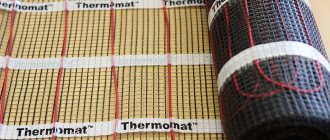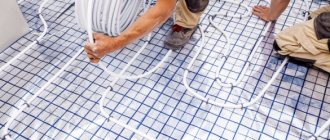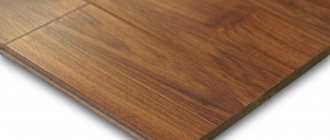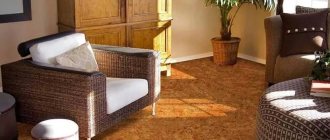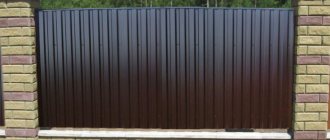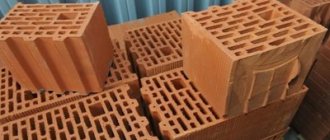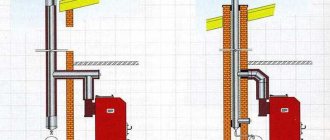The entrance hall is the first to greet guests. She is the face of the whole house, creating the mood and characterizing the owners. In addition to the fact that it should be cozy and beautiful, it is important to think about its practicality. When thinking about what the floor in the hallway will be like, you should take into account the features of this room and combine the aesthetic side with functionality. Nowadays, there are many types of flooring with different technical and visual characteristics. It won’t be difficult to choose one that suits your color, design and other requirements.
Option for flooring in the hallway.
No. 1. Linoleum
Linoleum has been and remains the most popular material for finishing the floor in the hallway. This is explained by its low cost along with a lot of positive qualities: moisture resistance, durability, ease of care, a huge variety of colors .
Linoleum can be one of the following types:
- synthetic linoleum is familiar to each of us, and this is what is meant in 99% of cases when they talk about linoleum. The main advantage is the widest choice of design; the material can imitate wood, tile or the seabed, and quite accurately. It is inexpensive, but dents from heavy furniture will remain, as well as black marks from shoes. For a hallway with heavy loads, you can choose semi-commercial or commercial linoleum – such material will last longer than household material;
- natural linoleum, or marmoleum. This coating is more natural and environmentally friendly than synthetic linoleum, as it is made from wood chips, resin, chalk, and linseed oil. The material is durable, has antibacterial and fire-fighting properties, but is more expensive than its artificial counterpart, and its installation process is more labor-intensive;
- piece linoleum, also called vinyl tile. It has all the same properties as synthetic linoleum, but with the help of individual squares you can lay out interesting designs, create a mosaic, and if something happens, replacing one damaged element will not be difficult. So, if somewhere the covering is torn or pressed under the influence of a furniture leg or heel, then only one square will have to be replaced, and the hallway will again have a neat appearance.
What can you put on top of the cover at the entrance?
After finishing the finishing work, you should think about what to put on the floor in the hallway on top of the flooring. Usually, to compensate for the cold floor in the hallway, the owners lay small rugs or carpet runners, but for the entrance area directly at the threshold, it is recommended to lay a rubber mat that will help cut off dirt and dampness from the street.
The shape of the carpet and colors should be selected based on the configuration of the room and the overall color scheme of the walls and furniture. In addition to preserving heat, you can also lay a carpet on the floor in the hallway to simply update the interior at low cost.
No. 2. Ceramic tile
Ceramic tiles are another leader in the field of hallway floor finishing. The material has gained wide popularity due to a number of advantages that are invaluable in the hallway:
- high strength, wear resistance, moisture resistance, abrasion resistance;
- easy to maintain, resistant to various detergents;
- durability;
- environmental friendliness;
- a huge range of colors, patterns and sizes, so you can decorate the hallway in any style. In addition, tiles can imitate the surface of other materials.
Among the disadvantages of ceramic tiles, the only thing worth noting is that their surface is cold, but for a hallway this is not such a disadvantage. A more serious disadvantage is fragility. If a heavy object falls on the floor, there is a high probability that the tiles will be damaged.
It is worth noting that not just any tile is suitable for a hallway . So, you need to pay attention to strength, which is determined by classes from I to V. The most durable tiles of the V class are used in public spaces with a huge traffic of people, and for the hallway, material with strength III-IV is perfect. An important indicator will also be the resistance of the material to chemical influences: according to this indicator, tiles are divided into classes A, C and D. AA tiles are the most resistant to chemicals, but at the same time quite expensive, and AC class material is optimal for a hallway. And one more requirement for tiles in the hallway is the most non-slip surface, so it is better to pay attention to products with a matte or corrugated surface.
How to make a warm, cold corridor in a private house?
≡ 11 October 2017 · Category: Heating
A cold corridor in a privatized house or, as it is sometimes called, a vestibule, seems to be not the most necessary room. And thanks to this, few people pay the necessary attention to its arrangement. However, if you weigh the arrangement and design, you can make such a corridor not only warmer, but also practical and stylish.
Purpose
First of all, you need to decide what the cold aisle will be used for. Any option must be considered in detail.
No. 3. Porcelain tiles
This material has become widespread relatively recently, and today, based on all its indicators, it is considered a unique method of finishing floors. In most properties, porcelain stoneware resembles ceramic tiles, but the peculiarities of manufacturing technology make it possible to obtain an even more durable material, which is superior in characteristics to tiles and even stone.
The main advantages of porcelain stoneware are:
- high strength;
- resistance to abrasion, moisture and fire;
- durability;
- safety;
- ease of care;
- sufficient assortment. Porcelain tiles can imitate any other material, have any color and pattern, and the surface can be embossed.
Among the disadvantages, it is worth noting the cold surface and high price. Porcelain tiles will serve you faithfully for many years, and any impact in the hallway, be it dog paws or dirty shoes after a walk in the rain, will not matter to such a coating. On the other hand, some experts express their doubts about the advisability of using such an expensive and so durable material in a residential area. The decision must be made in each specific situation, taking into account individual requirements and preferences.
How to insulate a corridor in a private house from the inside - All about insulation and energy efficiency
The issue of insulating a house from the inside causes a lot of controversy. There are people who are ardent opponents of this method of insulation, and there are also those who believe that thermal insulation will help make the house more comfortable and warmer. In this article we will not support either side, but will simply try to understand the features of internal insulation of a house.
The essence and problems of internal insulation
The concept of “insulation inside” means covering the surface of the walls with special insulating materials.
Many experts are against indoor insulation. In their opinion, it is better to use internal insulation only as a last resort, because this method of thermal insulation causes serious problems:
- The walls do not warm up . The lack of internal insulation allows warm air from the room to pass through the walls and warm them. After covering the inside of the wall with insulating material, warm air does not have the opportunity to escape outside. The walls of the room do not heat up. Moreover, cracks begin to appear on them over time.
- Condensation _ Condensation appears under insulating materials after a minimum period of time. Its appearance will reduce the thermal insulation properties and also promote the formation of fungus. Ultimately, this will lead to the gradual destruction of the wall.
- "Steals" the area . Unfortunately, experts have not yet come up with thermal insulation materials that would be thin. Most insulation materials have a thickness of 5 cm or more. And this significantly reduces the total area of the room.
No. 4. Laminate
Laminate is infrequently, but still used to decorate the hallway. This is a multi-layer coating that becomes a budget alternative to parquet, and at the same time can imitate not only any type of wood, but also tile or stone. Among other advantages of laminate it is worth highlighting:
- ease of installation and maintenance;
- strength;
- safety;
- good wear resistance;
- acceptable price.
Naturally, for the hallway it is better to choose a moisture-resistant laminate , as well as provide reliable waterproofing and treat the joints with moisture-resistant impregnation. Under such conditions, moisture will be practically harmless to the coating, but it is still better to wipe it off immediately if it gets on the floor. Laminate of classes 31 and 32 is perfect for the hallway, which will withstand the current loads. If the installation is done correctly, the laminate will turn into a durable coating. However, it is recommended to combine laminate with more durable coatings and... So, for example, the area near the threshold can be tiled, and laminate can be used in the rest of the hallway.
Insulation with bricks
The technology for insulating a wooden house from the outside using brick is quite simple - anyone can master it.
First of all, you need to remember that the brick cannot be laid directly on top of the thermal insulation - you should always leave a ventilation gap of about 2-4 cm. Thanks to it, excess moisture will not appear, which will reduce the service life of the brick, and the thermal insulation will lose its properties due to moisture .
A brick wall will have a lot of weight. Therefore, you cannot lay bricks directly on the ground. It is necessary to arrange something like a strip foundation 25 cm wide with a depth reaching the freezing point of the soil. The concrete must set completely before work can continue.
Waterproofing is laid on top of the concrete - it is better to use roofing felt as a strong and durable material. It will protect not only the brick, but also the external insulation for the walls of a wooden house from fumes from the ground.
When laying, do not forget to use a level and plumb line to identify any deviations vertically or horizontally. Even a small unevenness will become noticeable after a few rows, and possibly interfere with further work.
To ensure reliable connections between the wall and the brick insulation, metal pins must be used. They are driven into the wall and mounted between the bricks. They need to be installed between every 4-5 rows of bricks.
The installation process is simple. You don’t have to be a professional mason to figure out how to insulate an old wooden house with bricks. But you will have to show maximum accuracy and pedantry.
No. 5. Parquet board
If one person or a small family without animals or children lives in the apartment, then in the hallway you can use less durable materials, which include parquet boards . This material consists of three layers: the bottom two are inexpensive wood, and the top one is made of valuable species, which determines the appearance of the coating. It is the appearance that is the main advantage of a parquet board ; among its other advantages, it is worth noting its naturalness, environmental friendliness, and many installation options, thanks to which interesting solutions are achieved.
The three-layer structure of the material and the different directions of the fibers of the layers make it possible to increase resistance to humidity and temperature changes, and the protective coating and layer of varnish protect the parquet board from negative influences. On the other hand, parquet boards are not the cheapest materials; they will require careful care, which will not help if there are scratches from shoes, dirt and sand. You can sand the parquet board several times, after which the coating will not be repairable.
Block parquet has similar properties, but consists of solid wood. Hence the higher price, but also the opportunity to remove the top layer many times to renew the coating and give it a flawless look.
With frequent contact with dirt, both parquet floorings quickly lose their appearance, so they are rarely used in hallways. If the hallway is not the smallest, and you want to create a cozy classic interior using wooden floors, then it will be durable if you combine parquet with tiles near the threshold. Considering the variety of these types of coatings, as well as the ability to find tiles that imitate parquet, there should not be any difficulties.
Recommendations
The following designer tips will help you figure out what is best to choose from materials for the entrance group.
By color scheme
The choice of colors for the flooring in the hallway should be carried out simultaneously with the selection of material for the walls and taking into account the color scheme of future furniture.
It should be remembered that light colors will help visually expand the room, while dark colors, on the contrary, will reduce the volume. In addition, dust and stains from dirty shoes are very visible on a dark floor.
In small rooms, it is recommended to choose a floor covering that is a tone or semi-tone darker than the tone of the furniture.
For apartment
Unlike a country house, for a city apartment there are practically no restrictions on the use of flooring materials. In large rooms, it is recommended to lay tiles near the door, combining them with parquet boards in the hallway. In small hallways it is better to use only one finishing material.
For a country house
A modern country house is almost no different from urban housing in terms of comfort and amenities, but when decorating the entrance to a private cottage, additional restrictions must be taken into account. In a city dwelling, a person enters an apartment through the entrance, so some of the dirt and moisture remains on the staircase. In a country house, a person immediately enters the hallway, and therefore the requirements for coverage increase:
- it should not slide;
- it should not absorb or allow water to pass through.
Therefore, it is best to lay ceramic tiles or porcelain stoneware in the hallway of a private house.
No. 6. Carpet
Previously, carpets decorated many apartments, and their place was not only on the floor in the living room and bedroom, but also on the walls and even in the hallway. It is clear that a fleecy carpet and a room such as a hallway are incompatible things, but carpet is quite suitable. We are talking about artificial carpet , because natural carpet will absorb moisture too well and retain it, deteriorate and wrinkle.
Artificial carpet does not wrinkle, is easy to clean, and insects will not live in it. This coating makes the hallway cozy and soft. For these purposes, it is better to choose the most dense carpet, while the pile height should be minimal. The best option for a hallway is a carpet made of nylon , but analogues made of polyester, acrylic and polypropylene also perform well. There are several methods for making carpet, but woven carpet is better suited for a hallway - it is the most reliable, but there is not much of it on the market. Needle-stitched carpet is inferior in performance, but is also not afraid of dirt and water.
Beautiful design ideas
The hallway is rarely decorated and usually remains the most boring room in the house, but this can be corrected by choosing a bright, unusual floor! The easiest way is to use tiles for these purposes: they are laid in a checkerboard pattern, assembled into geometric patterns, and used to create designs.
The second option is also with tiles, but not monochromatic, but printed: this in itself is an accent and does not require additional effort.
You can also change the installation method. For example, lay a regular laminate diagonally, or assemble a beautiful Christmas tree from multi-colored parquet.
The photo shows an unusual tile pattern
No. 7. "Golden" tile
A material with a rather curious name appeared quite recently, and so far it is produced only in South Korea. The material is unique in all its properties, and all its characteristics are explained by a six-layer structure: the base is PVC, and on top of it are layers of crushed natural stone with resin, fiberglass, a wear layer, the top layer is a protective film.
Among the main advantages of this material it is worth noting:
- durability;
- wear resistance, which in the country of origin of this finishing material is determined by the number of steps. Thus, “golden” tiles will withstand 10 million steps, which means that the average family can walk on the material 24 hours a day for 10 years;
- resistance to moisture and fire, to household chemicals;
- comfortable to the touch and non-slippery surface;
- ease of care;
- the presence of a decent number of design solutions, up to the most accurate imitation of other finishing materials.
The price for such finishing material is average, and the only negative is that it is not so easy to find in stores.
The final stage. Installation of skirting boards
The plastic plinth is attached to the wall with self-tapping screws.
There are skirting boards in which the screws are hidden inside, but such skirting boards are not particularly practical. The middle constantly falls out and becomes deformed. Therefore, I chose a regular plastic plinth, which is screwed on top with self-tapping screws.
The baseboard should be chosen to match the color of the linoleum, as should the thresholds. Everything should be harmonious and combined. To install the plinth, you need to measure and cut the required pieces of plinth. Connect them using fittings, making an angle.
Thus, install the plinth along the entire surface of the junction of the wall and the floor in the corridor. Finally, install the fittings on the ends of the plinth. This is the completion of the work.
The laying of linoleum with insulation of the floor surface in the corridor is completed. The floor has become much warmer, stronger and improved in appearance.
Privacy Overview
This Personal Data Privacy Policy (hereinafter referred to as the Privacy Policy) applies to all information that the website https://rems-info.ru (hereinafter referred to as rems-info.ru) located on the domain name rems-info.ru (as well as its subdomains), can obtain information about the User while using the site rems-info.ru (as well as its subdomains), its programs and its products.
Using the site
rems-info.ru means the user’s unconditional consent to for processing his personal information
specified therein in case of disagreement with these conditions, the user must refrain from using this resource. 1. Definitions and terms
1.3. User – an individual using the site rems-info.ru.
1.4. Personal data - information relating to a specific User, in accordance with the Federal Law of the Russian Federation “On Personal Data”.
1.5. Cookies are pieces of data sent by a web server to a browser when you visit a site. R ems-info.ru automatically receives certain types of information obtained during user interaction with the Site. We are talking about technologies and services such as web protocols, cookies, web tags, as well as applications and tools of the specified third party. Cookies.
A cookie is a piece of data that is automatically placed on your computer's hard drive each time you visit a website. Thus, a cookie is a browser's unique identifier for a website. Cookies make it possible to store information on a server and help you navigate the web more easily, and also allow you to analyze the site, evaluate results and target behavioral advertising. Most web browsers allow cookies, but you can change your settings to refuse cookies or to track where they are sent. However, some resources may not work correctly if cookies are disabled in the browser.
1.6 The site rems-info.ru does not control and is not responsible for third party sites that the User can access via links available on the Site.
2. Personal information of users that is received and processed by the site
rems-info.ru
2.1. For the purposes of this Policy, “user personal information” means:
2.1.1. Personal information that the user provides about himself independently when leaving an application, making a purchase, registering (creating an account) or in another process of using the site.
2.1.2. Data that is automatically transmitted by the site rems-info.ru during its use using software installed on the user’s device, including IP address, information from cookies, information about the user’s browser (or other program through which the site is accessed) ), access time, address of the requested page.
3. Conditions for processing the user’s personal information and its transfer to third parties
3.1. The rems-info.ru website stores personal information of users in accordance with the internal regulations of specific services (Yandex Metrica, Google Analytics, hosting provider).
3.2. With regard to the user’s personal information, its confidentiality is maintained, except in cases where the user voluntarily provides information about himself for public access to an unlimited number of persons.
3.3. The rems-info.ru website has the right to transfer the user’s personal information to third parties in the following cases:
3.3.1. The user expressed his consent to such actions by agreeing to provide such data;
3.3.2. The transfer is necessary as part of the user’s use of a certain website rems-info.ru or for the provision of goods and/or services to the user;
3.3.3. The transfer is provided for by Russian or other applicable legislation within the framework of the procedure established by law;
3.3.4. In order to ensure the possibility of protecting the rights and legitimate interests of the site rems-info.ru or third parties in cases where the user violates
User agreement of the site rems-info.ru.
3.4. When processing personal data of users, the rems-info.ru website is guided by the Federal Law of the Russian Federation “On Personal Data”.
4. Changes to the Privacy Policy. Applicable Law.
4.1. R ems-info.ru has the right to make changes to the privacy policy unilaterally. Changes come into force from the moment they are published on the website.
4.2. This Policy and the relationship between the user and the Site rems-info.ru arising in connection with the application of the Privacy Policy are subject to the law of the Russian Federation.
Source
No. 8. Self-leveling floor
Self-leveling flooring is an excellent option for any room, incl. and for the living room. The material can have any color and pattern: be either plain or with any pattern, imitate wood, the seabed, etc. In terms of its performance qualities, self-leveling flooring is a real godsend for a hallway . It is distinguished by such advantages as:
- wear resistance, resistance to moisture, mechanical influences, chemical agents;
- ease of care;
- solidity;
- durability.
In all respects, this is an excellent hallway covering, which, even despite many negative influences, will remain in its original form after many years. The cost of self-leveling floors is high; all work must be carried out by professionals, but such costs are offset by performance.
Heating options
But let’s say it’s firmly decided that in the hallway you can’t do without heating the floor. In this case, it is necessary to select a specific option. The choice, as usual, will mainly have to be made between electric and water appliances. Please note: instead of water, antifreeze can also be pumped through pipes, but this is less common due to its high cost. Electrical systems are more diverse:
The water heater is environmentally and sanitary safe. The relatively low temperature makes it possible to reduce fire risks to the limit. Moreover, even if there is a failure in the general building or local heating, thermal inertia will persist for some time. Short-term problems will not be noticed at all. Since there are no radiators, the corridor space is fully used, and the device itself turns out to be very economical.
But you need to understand that tubular heated floors:
Electrical systems can be used anywhere without any restrictions. They are installed simply and quickly. Replacement if necessary is not difficult.
However, you will have to pay extra for electricity. In addition, every device that consumes it is a source of potential danger.
